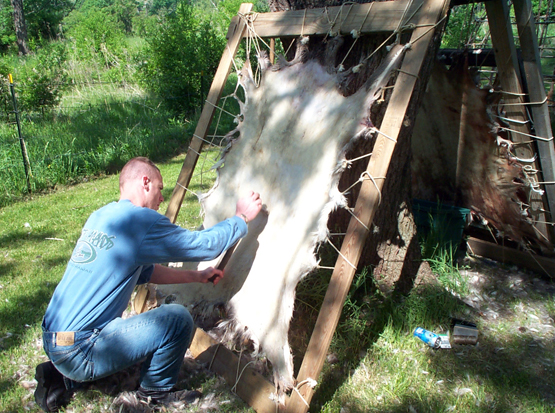Before the advent of chemical tanning of hides to make leather, animal skins were subjected to all kinds of strange concoctions to degrease and soften them. Urine, wood ashes, tree bark acid, and even toxic substances like mercury have been employed over the centuries to tan skins into useful leather.
But few natural substances have had such a long and successful track record as animal brains. How does it work? Brain tissue is full of very fine oils that condition and soften the animal skin, if the skin is moving while it dries. If the skin just lies there and dries out, brains or no brains, the glues in the skin naturally set up and you have “raw hide” as the result–great to let the dogs chew on, but not so great for making clothes.
I use the “dry scrape” method of brain tanning, which involves stretching a clean hide in a wooden rack to dry, scraping the hair off after the hide dries, soaking the brain tissue into the hide, and then using a lot of elbow grease to stretch the hide while the brain solution is drying. If this all sounds like a lot of work, you’re right. But stretching the hide as the brain dries creates leather that is soft and stretchy like chamois cloth. And if you don’t have access to modern tanning chemicals, this is the next best thing. Here are the steps you’ll need to take.
Step 1: Flesh the hide
Estimated time: One hour
Fleshing the hide involves scraping off all of the meat and fat. This is necessary to prevent the hide from rotting, and to allow a hide to be tanned properly. Bloody, dirty hides can be washed in water, with or without soap, before and/or after fleshing.
Step 2: Dry the hide
Estimated time: Hours to days, depending on the weather
Drying the hide involves stretching out a hide flat and allowing it to dry, so that it may be properly scraped. I poke holes around the hide’s perimeter and lace some rope through the holes to tie the hide into the wooden frame. Once the hide is tied up in the rack, leave it to dry out.
Step 3: Scrape and sand the hide
Estimated time: Roughly two hours
Scraping and then sanding are done to remove the hair and outer layers of the skin so that the brains will soak all the way through the skin. The tool of choice is a rounded steel blade on a handle, resembling an adz.
Step 4: Wash the hide
Estimated time: 20 to 30 minutes
Washing the hide is important for removing any remaining grease, which will interfere with the tanning process. This is an optional step that can be skipped if the hide doesn’t seem too greasy.
Step 5: Wringing the hide (if the hide was washed)
_Estimated time: 10 min
_
Wringing out the hide removes the water from the hide so that the brain solution may soak into the hide.
**
Step 6: Brain the hide**
Estimated time: Two to eight hours
Braining the hide introduces fine, emulsified brain oils into the hide so that it can be soft tanned. For tanning one deer hide, mix one deer brain into a gallon of hot water and mash the brain until it looks like a soup. Soak the hide in the brain soup for 2 to 8 hours. The longer you soak it, the better.
In an area where CWD is prevalent in the deer herd, deer brains should not be used. However, a dozen egg yolks (no whites) added to a gallon of warm water makes a substitute solution for brain tanning.
Step 7: Stretch the hide
Estimated time: Three to nine hours, depending on the weather
Stretching the hide is necessary to soften it. The hide must be stretched until it is completely dry in order for it to remain soft. You can stretch it tied up in the rack, poking it with a stick, or you can pull it by hand. Don’t let the hide get wet after stretching and before smoking (the next step). An un-smoked hide will dry with hard spots and patches if it gets wet before smoking.
**
Step 8: Smoke the hide**
Estimated time: One hour
moking the hide coats the hide fibers with “tar” to keep the brain oils on these fibers. This allows the hide to get wet and then remain soft after drying without stretching it again.
The end result is a highly coveted brain-tanned buckskin. Small deer skins tanned this way go for $100 a pop at frontier reenactments and similar events.
Let us know in the comments if you’ve tried this method, or have any questions about it. Good luck tanning!

THE ULTIMATE SURVIVAL MANUAL
Check it out for more great survival skills.
